How to grow roses from cuttings
Delicate roses in a bouquet are always an appropriate addition to a celebration or a romantic meeting. We will tell you how to recreate the fleeting beauty of flowers from a bouquet in your garden, and we will also help you prepare cuttings from which annual flowering bushes will later grow.
When is the best time to take cuttings?
Spring is the best time to take cuttings of roses, but the maximum number of viable shoots remains after autumn pruning of roses for the winter. During this period, material for propagation is also harvested, and in larger quantities, since not all of them will germinate.
Regardless of the season, when cutting stems, it is important to observe the following conditions:
- shoots are taken from a healthy, developed and strong plant;
- branches should not be damaged by frost;
- in the axils of the leaves there should be well-defined buds;
- pruning tools must be sharp and clean;
- the process is preferably carried out in dry weather.
The cuttings from the shoots on which the buds are formed are considered to be the most viable. You can root material from bouquets all year round, extending the daylight hours with a phytolamp using growth stimulants, but the best time for this is spring and summer. 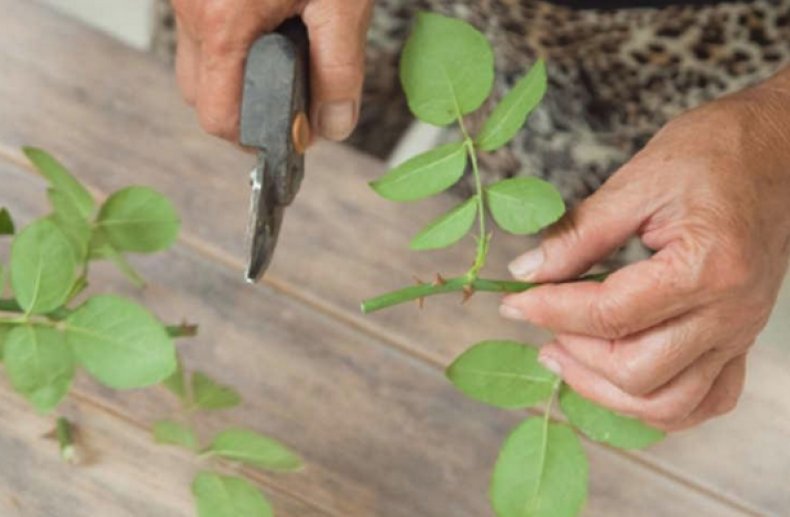
Important! The rate of appearance of roots depends on many factors, variety, season, weather and can vary greatly.
How to cut cuttings
When cutting planting material from a bouquet, stems 0.7-1 cm thick are used. It is important that the flowers are fresh.
This is determined by the following features:
- the stem is elastic, has a uniform light green color;
- the skin on the stem is smooth, even, glossy, without spots;
- leaves and bud are fresh, without damage.
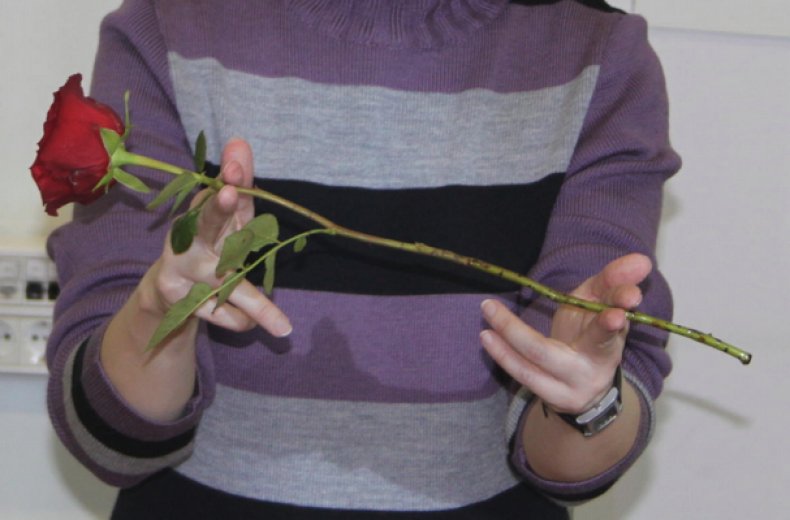
Carefully inspect the bottom of the stem. Find a spot with 3-4 viable buds. They are located at the point of attachment of the leaf, look like lighter tubercles. The kidneys should be sufficiently pronounced, not have darkening, black tips and injuries.
Having chosen a suitable place, cut the stem under the lower kidney, stepping back 1-2 cm from it. The upper cut of the cutting will pass 1-2 cm above the upper kidney. 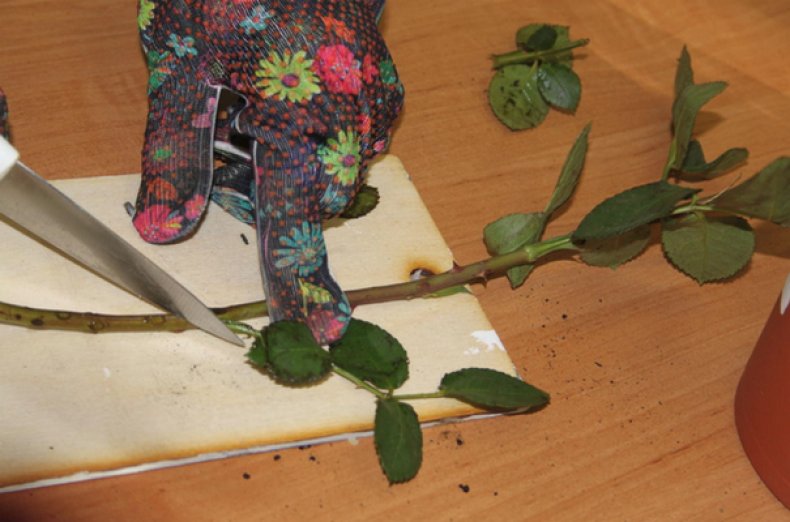
How to root
There are several ways to root the resulting material. Each of them has its own advantages and is tested by gardeners in practice.
In water
The prepared cuttings are placed in a container with water, immersing the tips in water ¼ of the length. To increase the chances of success, they can first be soaked in a solution that not only stimulates root growth, but also protects against diseases. The container is kept in a warm place, the water is changed daily.
Water should be at room temperature, purified or settled for 48 hours. As soon as roots appear on the lower cut, the seedlings are transplanted into nutrient soil in a flowerpot or open ground, if the temperature allows. The advantage of this method is simplicity and accessibility. 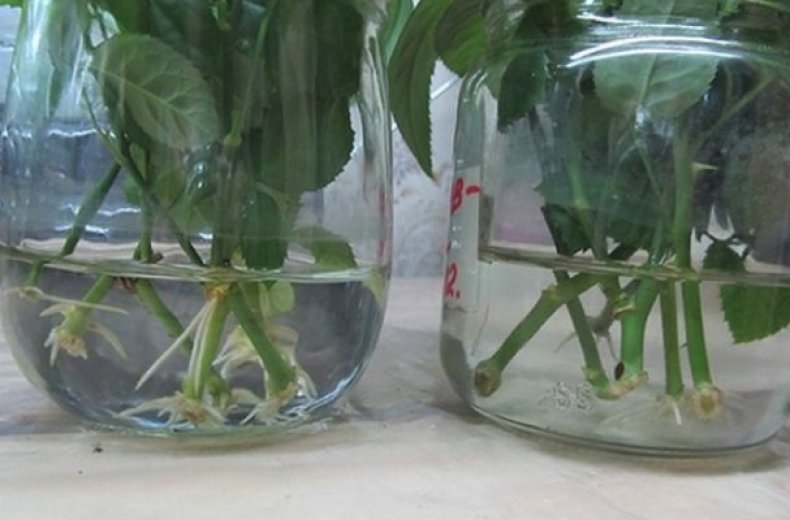
in the soil
For rooting in the soil, in addition to cuttings, you will need the following materials:
- a flowerpot with a volume of 0.5-0.7 liters, with large drainage holes in the bottom;
- root growth stimulator, a biological product for the prevention of root rot;
- the soil;
- plastic bottle with cap.
Important! It is better to use a special soil mixture for roses, its composition is optimally selected for these flowers, the soil is free from pests.
It is advisable to add sphagnum moss to the soil for better air penetration and water outflow. It will absorb excess moisture, saturate the soil with air, as a natural antiseptic, it will not allow seedlings to die from rot.
Video: rooting rose cuttings from a bouquet Perlite, a natural mineral, has similar properties, which also will not allow the soil to acidify. The flowerpot is filled with soil, the soil is compacted. 1 tablet of glyocladin is added to the flowerpot to protect the roots from disease and decay.
The lower cut of the cutting is dipped in root powder to stimulate root growth. The cutting is buried in the ground, leaving 2 buds on the surface. The distance from the lower bud to the surface of the earth is 2-3 cm. The seedling is watered, dry soil is added to the flowerpot, since after watering the soil settles slightly.
Did you know? The oldest image of a rose was found on the island of Crete and dates back to the 2nd millennium BC. e.
To protect against dry air, especially during the heating season, the cutting is covered with a transparent cap. It is nothing more than the top of a cut plastic bottle with a cap. To ventilate the cutting, the lid is unscrewed. As rooting, the airing time is increased.
The flowerpot is placed in a warm, well-lit place, under indirect sunlight or slightly shaded. It is also important to avoid drafts. A successfully rooted stalk with the onset of heat is planted in a permanent place. 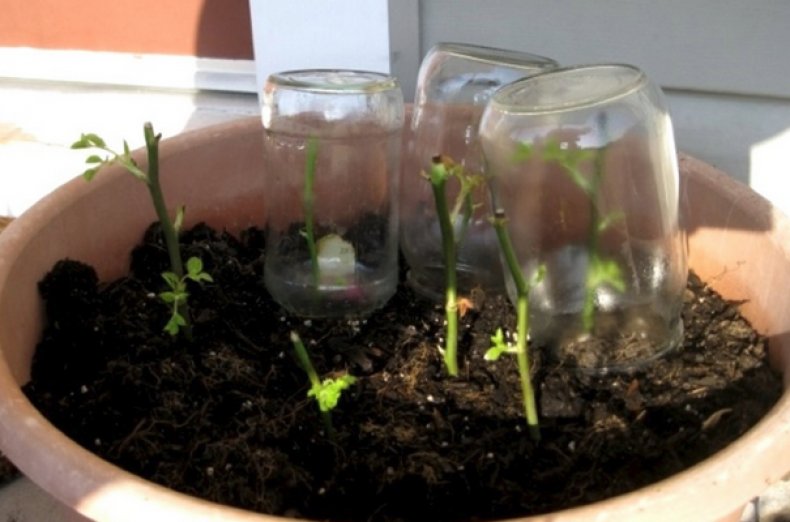
In the package
To root the cuttings this way, you will need 2 clean garbage bags, water, and a few newspapers. Prepared cuttings without leaves are wrapped in several layers of newspaper, previously soaked in clean water and squeezed out. The newspaper is folded, tightly closing the ends, the cuttings should be completely closed.
The flower is placed in one of the bags, the ends of which are tied, then wrapped in a second bag, which is placed in a cool place for 4-5 weeks. All this time it is necessary to maintain the humidity of the newspapers, slightly moistening them if necessary.
Video: rooting rose cuttings in a bag When an outgrowth of the nascent root system appears on the lower sections of the cuttings, they are planted for further rooting in the ground.
Common problems and mistakes of newbies
Even experienced gardeners treat the removal of rose seedlings from a bouquet as an experiment, the results of which cannot be absolutely accurately predicted.
Here are the factors that will reduce the likelihood of success:
- the use of stems that have stood in the water for a long time, as well as touched by frost;
- an attempt to use flowers soaked in preservatives;
- too high humidity;
- stagnation of water in the pot from excessive watering;
- insufficient watering;
- low air temperature, drafts;
- too dry air.
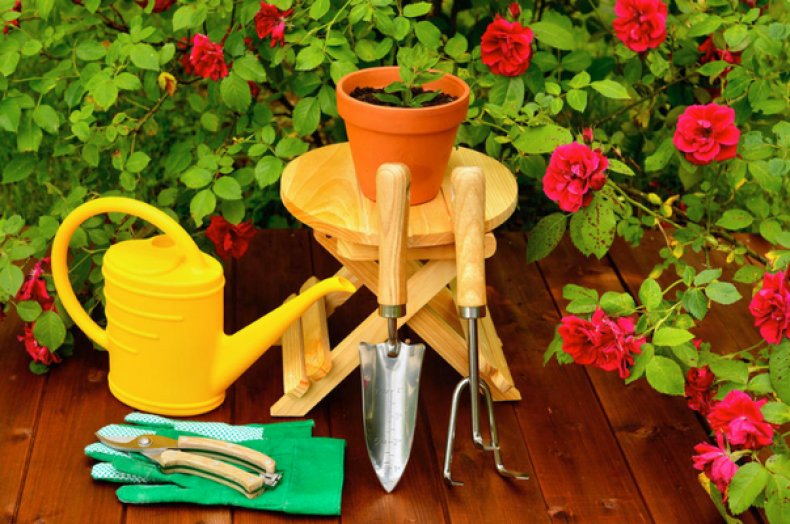
Did you know? Inhaling the aroma of a rose or rose oil, a person relaxes, becomes kinder and softer.
Do not be afraid to experiment, perseverance and perseverance will definitely be rewarded. We wish you success and lush flowering in your garden!
Reviews from the network
On the handle, you need to bury the lower kidney into the ground, roots begin to grow from it. It is desirable to plant the stalk at an angle. (But I don’t do that, then it’s inconvenient to put a jar). There will be no roots from the cutting itself. Yes, the cutting under the jar will feel great, grow leaves. You take off the jar and .... everything is gone. It was like that for me too. Here's what I found from the internet. ..."After the flowers stood in the vase for several days and the buds began to fade, the most important part of my work began. On each branch, I cut off a bud, left 4-7 buds, and cut all the leaves by a third. After that, I planted everything in the front garden, each branch under a separate three-liter jar (4 buds in the ground. And watered every third day. I planted roses in early spring, when it got warmer and in late autumn my branches were already with good roots. The next spring, I planted all of them on the plot and already in the summer, for the first time, my roses bloomed, albeit small, but very beautiful.

http://frauflora.ru/viewtopic.php?p=25733&sid=4721c499eac0085e43c1f4b831bacc52#p25733
Place the cutting in the water. when he gives roots - you can transplant into a pot. Usually I choose a cutting so that there are 2-3 buds, from the bottom, see 2-2.5. (maybe not right, but it grows with me) I make drainage in a pot, peat with sand on top, and in a ratio of 1/2 (that is, I share peat, 2 sand). Mineral fertilizer and the one that is sold in the store for roses. They planted it in a pot, poured it, covered it with a plastic tube (well, they took a plastic bottle, cut off the top and bottom. That's it), they pulled a film on top. The day is closed, then it closes at night, we open it during the day, after 5 days we remove the tube. That's when it grows something intelligible - you can transplant it from the pot into the ground. If there is a sharp temperature drop at night, it is better to cover. For the winter, we cut the rose, leaving all the same 2-3 buds (you can have more, of course), cover it with a wooden box and cover it with spruce branches, sawdust, or whatever. what is. the main thing is to be warm.
Everything is growing for me. The only thing is that sometimes the cuttings turn into a wild game. and you get not a rose bush, but a huge bush of something green and prickly.




